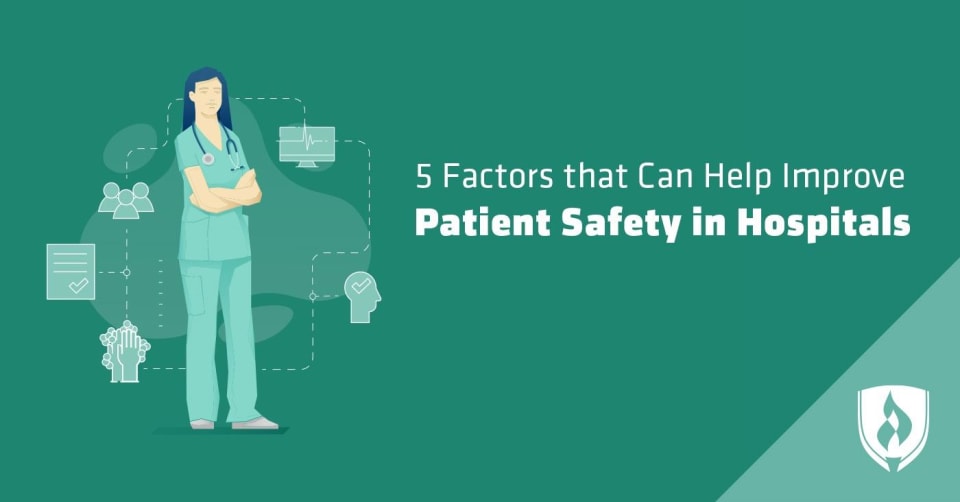
You take pride in being a part of a healthcare system that makes a positive impact for patients every single day. You know your daily work plays a real part in improving others’ health. That’s precisely why the talk about patient safety initiatives has caught your interest. Isn’t the whole point of medical care to improve patient safety?
The answer is yes, but it’s not as simple as it may seem. The medical community is constantly evolving, leaving plenty of room for improvement as it grows and changes. As hospitals grow larger and busier, safety measures that protect patients occasionally can fall through the cracks. Patient safety in hospitals has come onto the radar of healthcare workers who are dedicated to meeting their patients’ needs and keeping them safe at all times.
Read on to take an in-depth look at the definition of patient safety and the factors that can help you protect the patients who come through your facility.
What’s the definition of patient safety?
It’s easy to think of healthcare settings as naturally safe places, but in reality, hospitals can be filled with lurking dangers due to the potential for infections or medical errors. In fact, a 2016 study by Johns Hopkins University found that medical errors may actually be the third leading cause of death in the U.S.*
The good news is that errors can be corrected and prevented with proper safeguards. When we talk about patient safety, we’re talking about reducing the risk for those potential errors, injuries or infections. The Institute of Medicine has broadly defined patient safety as “avoiding harm to patients,” while the American Board of Preventive Medicine gets more specific, defining the avoidance of harm as “freedom from accidental or preventable injuries produced by medical care.”
Healthcare workers, medical associations and individual hospitals may have different definitions of patient safety—but it becomes obvious what patient safety isn’t when patients find their health compromised due to ineffective hospital procedures. Enter the patient safety initiative.
Patient safety initiatives are efforts from various healthcare facilities and medical associations to revise hospital procedures and train staff to work as a team to reduce errors and protect patients. There’s no magic pill that fixes issues of patient safety, but there are a number of factors that have been proven to help.
5 Factors that can help improve patient safety in hospitals
No matter how you define it, patient safety is nothing to take lightly. Each and every person who works in a healthcare facility has a part to play in keeping patients safe. Read up on these factors to discover what you and your healthcare facility can do to help.
1. Use monitoring technology
Healthcare workers care for several patients during their shifts; each one with varying needs and medications. The use of monitoring technology can help nurses and physicians verify that they’re always following the right procedure for the right patient and that they’re keeping on top of each patient’s needs.
Technology, such as bed alarms to notify staff if a patient falls or barcode systems that verify patient medication, are behind-the-scenes measures many hospitals are already taking to improve patient safety, according to Judith R. Sands, RN, healthcare professional and author of Home Hospice Navigation: The Caregiver’s Guide. Monitoring systems like these provide an easy way to catch and prevent harm from human error in hospitals.
2. Make sure patients understand their treatment
You may think all patient safety responsibilities fall to the healthcare provider, but making sure that patients are informed about their own care is also vital to preventing errors. This doesn’t mean patients need to have the same knowledge of their situation as a healthcare professional—but a high-level understanding of the treatment and the risks they face can go a long way. Simply asking patients to recall and restate what they’ve been told is a strategy with enough evidence to support its regular use in patient safety initiatives.
Patients and their family members are naturally focused on maintaining their own health. By verifying that they understand their treatment plan, medication and medical procedures, you’re giving them the tools they need to notice and prevent errors in their own care.
3. Verify all medical procedures
We’ve all heard the horror stories about a patient having their right knee replaced when it was actually the left knee that was scheduled for operation. Building regular verification processes into hospital procedures helps prevent errors like these.
The most famous example of this type of verification is the Universal Protocol, which helps prevent surgical errors by allowing any member of a surgical team to call a “time out” to verify the details of the surgery. However, Sands notes that verification also plays a part in other aspects of healthcare, such as verifying medication dosage and timing, or verifying that a provider followed handwashing procedures.
4. Follow proper handwashing procedures
Simple actions can have a big impact on patient safety. The Centers for Disease Control and Prevention (CDC) cites handwashing as one of the best ways to stop the spread of germs and prevent infections in hospitals.
The CDC’s Clean Hands Count campaign recommends that healthcare providers use alcohol-based sanitizer regularly, as well as have open conversations with patients about the importance of hand hygiene. This allows patients to take control of their own health by asking healthcare providers if they’ve washed their hands when they enter the room.
5. Promote a team atmosphere
Each and every member of a hospital’s staff plays a part in maintaining patient safety. Emphasizing teamwork and being honest with staff about their role in patient safety can make a big difference in your hospital’s culture and attitude toward preventing errors.
Sands shares that nurses and others with direct patient contact “Know the issues but often feel powerless and unappreciated for their hard work, which leads to reluctance to speak up.” She urges hospitals to share patient feedback and patient safety trends in their hospital, as well as forming interdisciplinary risk assessment teams to help address patient safety issues and promote teamwork among hospital staff.
Patient safety is in your hands
The small actions staff take on the job each day can have a big impact on patient safety in hospitals. Now that you’re aware of the factors that can help protect patients, you’ll want to learn more about how to provide the best possible care. Check out our article, “7 Critical Factors that Impact Patient Experience,” to learn more.
*Makary Martin A, Daniel Michael. Medical error—the third leading cause of death in the US BMJ2016; 353 :i2139




